Abstract
We isolated and characterized the first chromosome-specific satellite DNA (HC2sat) of Chinese hamster. This novel satellite was localized to the pericentric region of hamster chromosome 2. The 2.8 kb long repeat unit of HC2sat was identified and two such units were sequenced. Extended short range periodicity could not be revealed in repeat units. These elements are amongst the largest satellite repeat units reported from mammals to date. HC2sat is a major constituent of the pericentric region of CHO chromosome 2 representing a 7-14 Mb long DNA segment. Studies of long range organization of HC2sat indicated that the formation of the satellite array might occur in different phases and involved different amplification mechanisms.
Full text
PDF
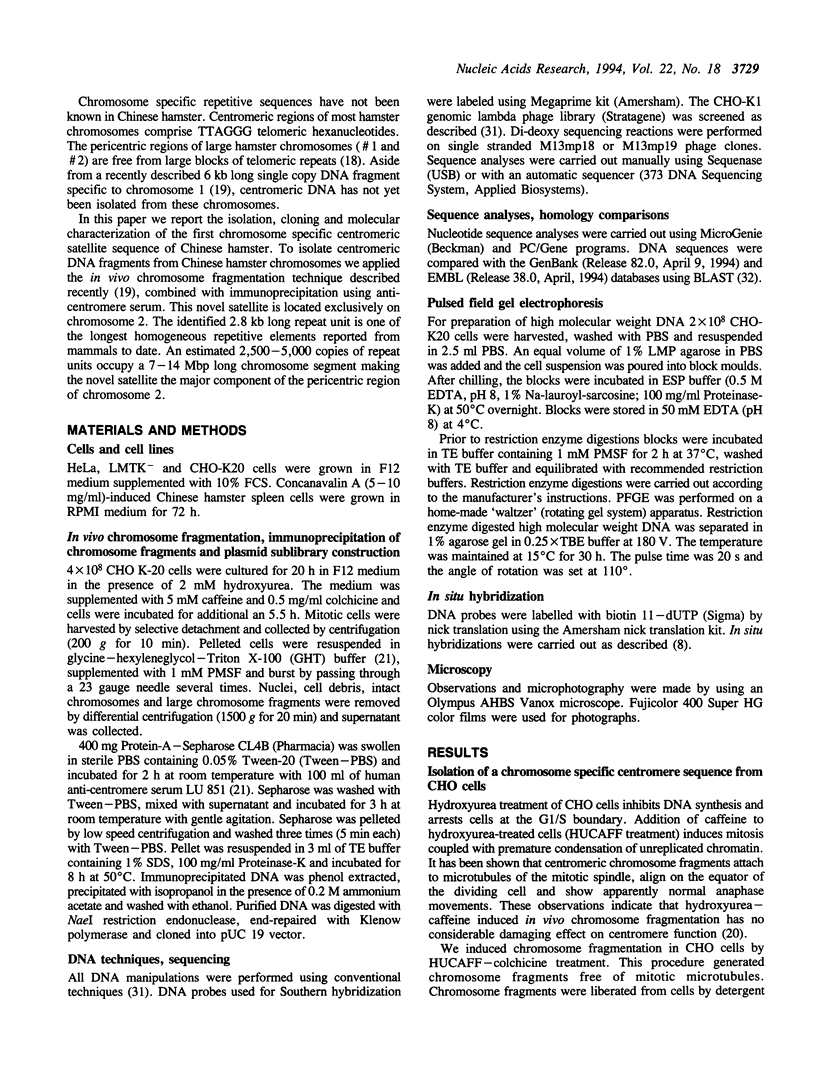
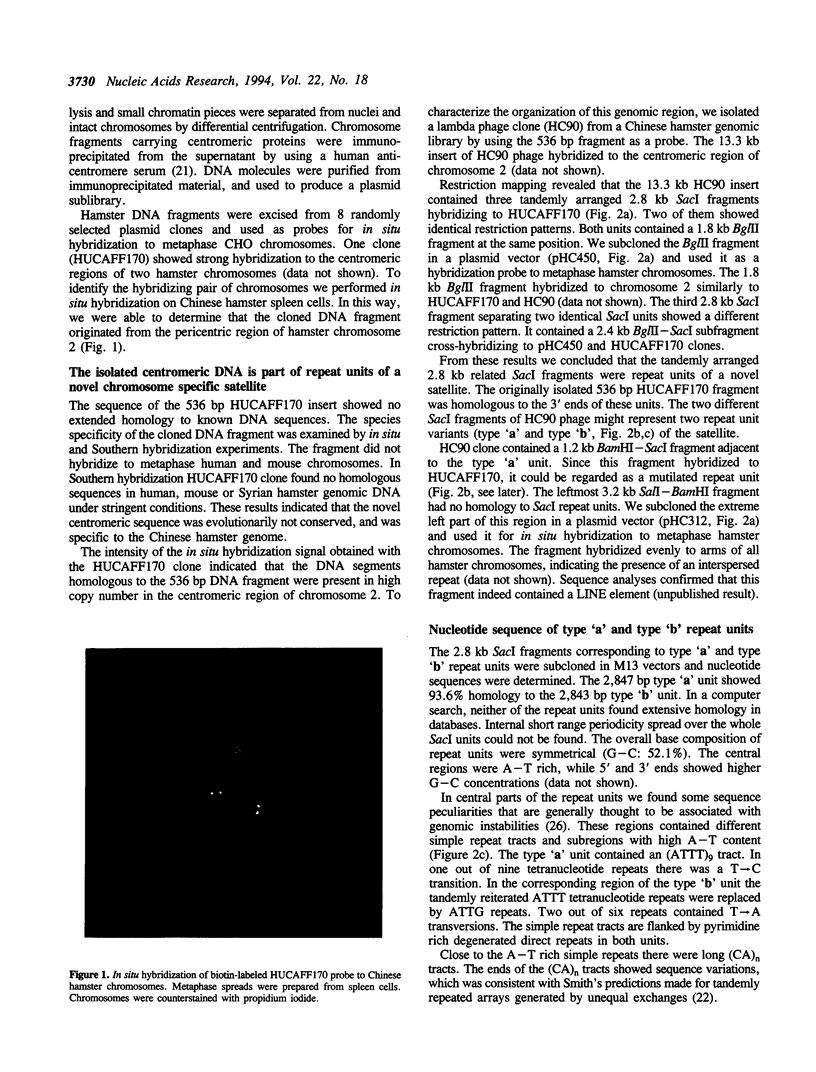

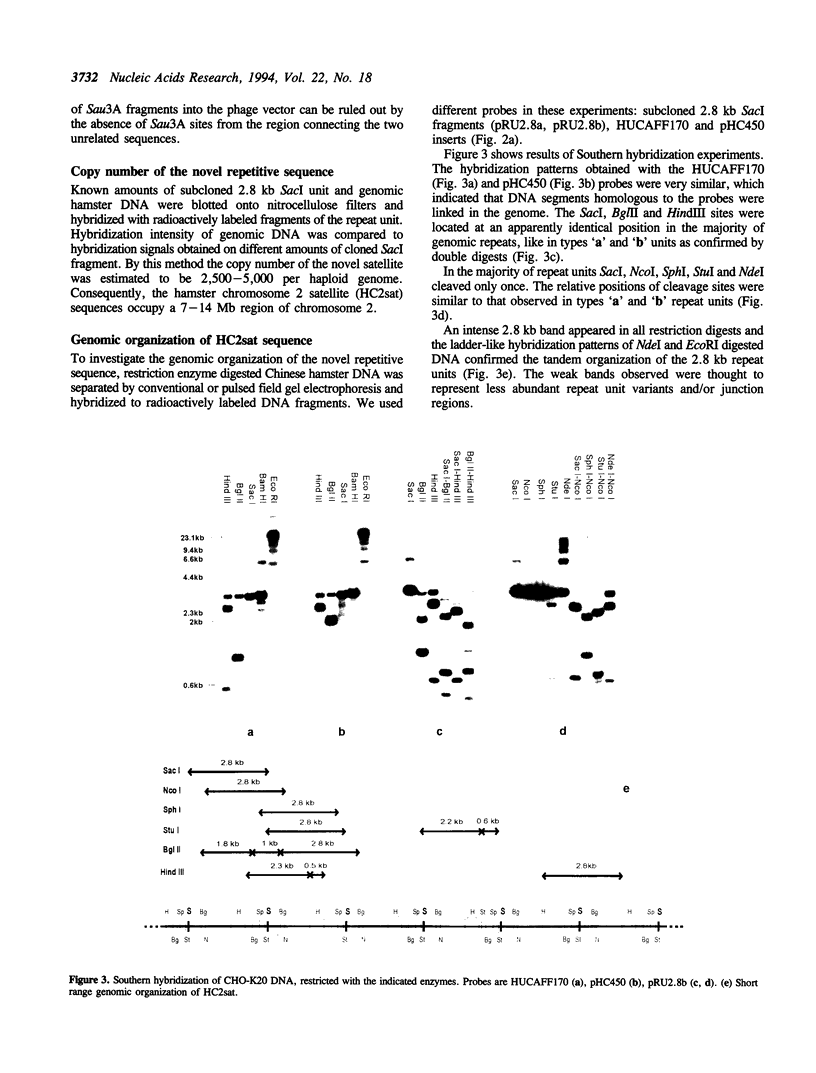
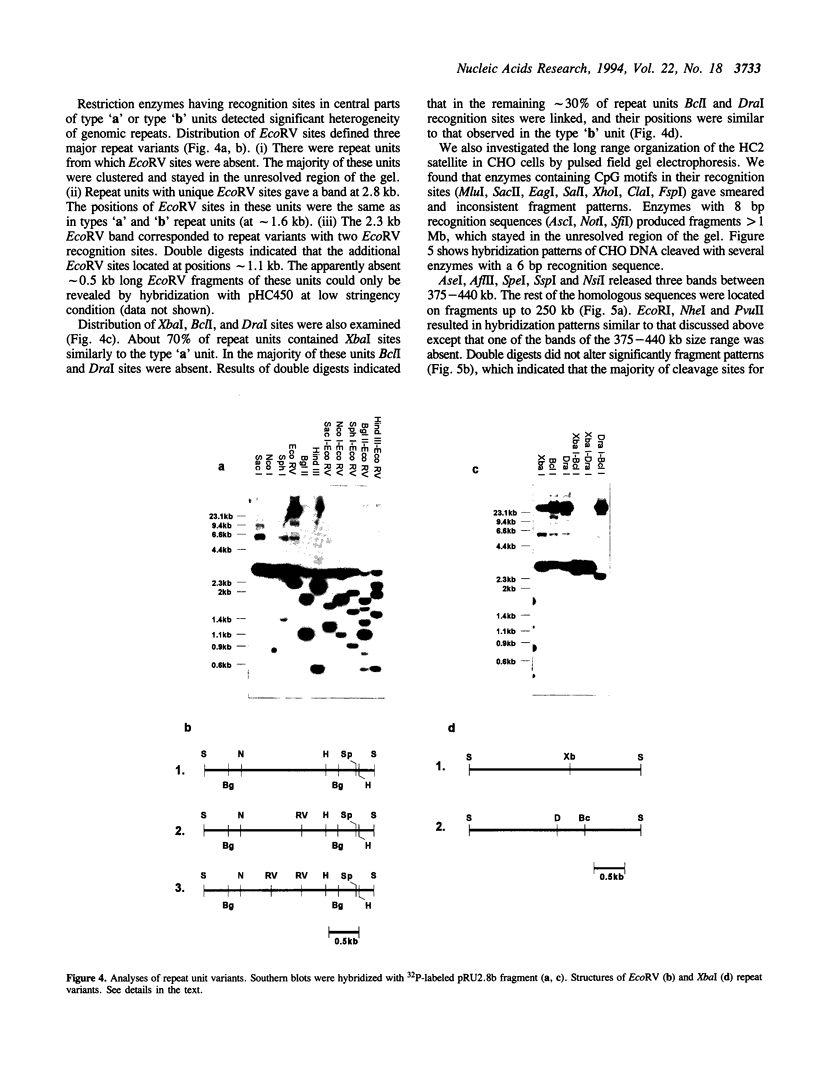
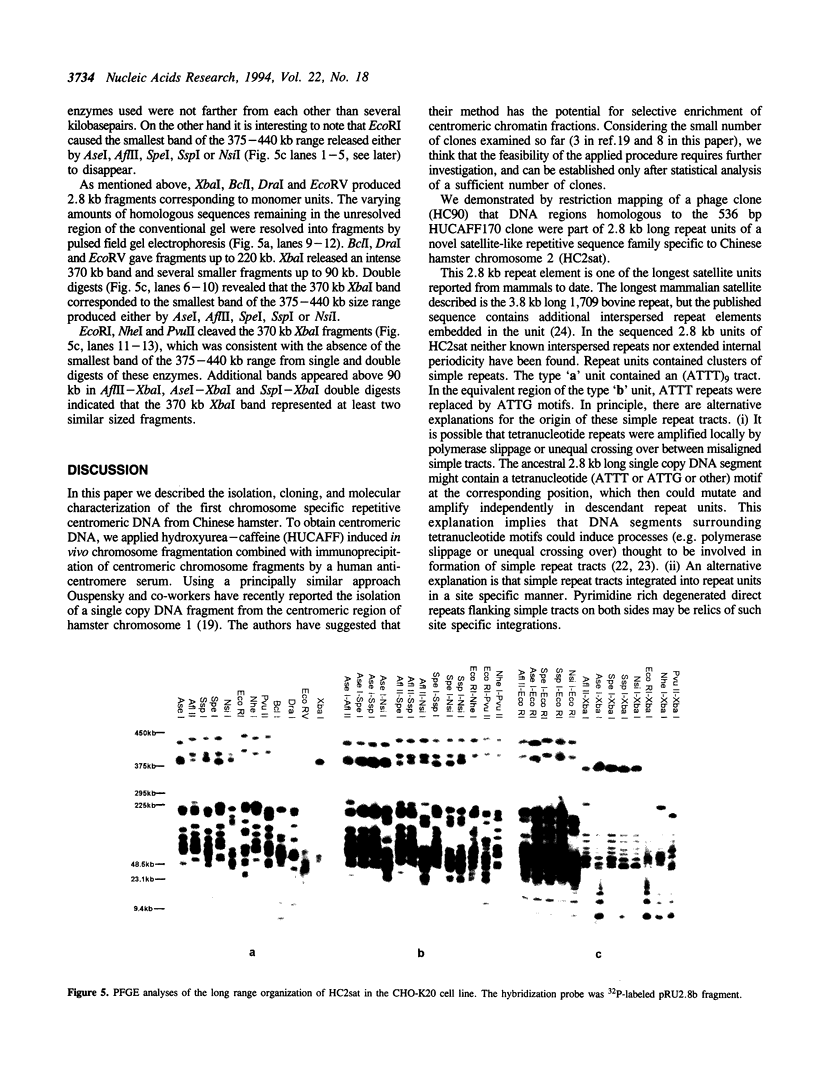
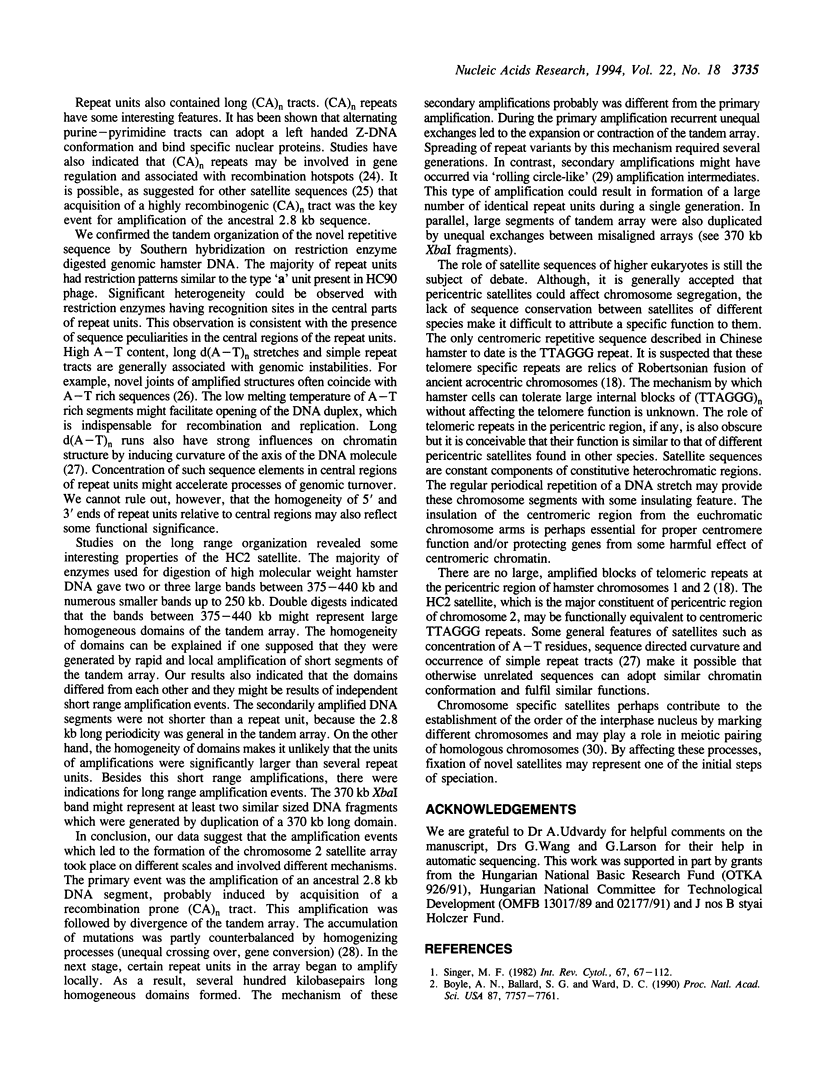
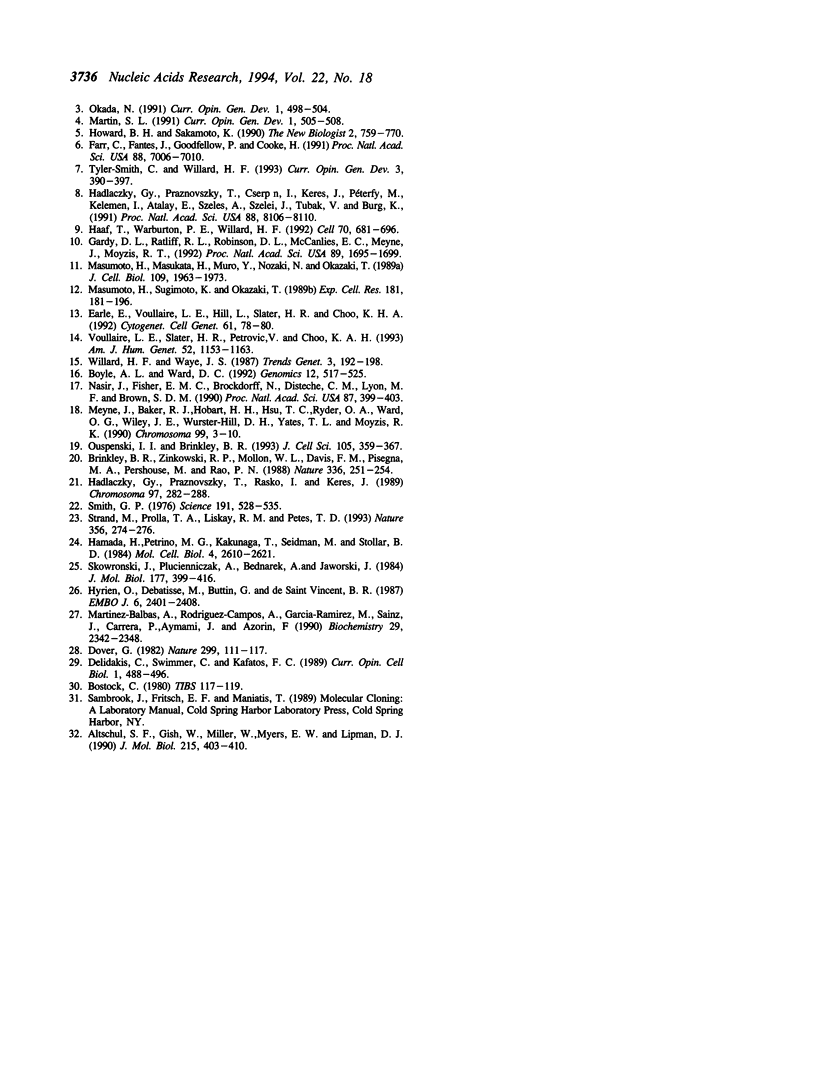
Images in this article
Selected References
These references are in PubMed. This may not be the complete list of references from this article.
- Altschul S. F., Gish W., Miller W., Myers E. W., Lipman D. J. Basic local alignment search tool. J Mol Biol. 1990 Oct 5;215(3):403–410. doi: 10.1016/S0022-2836(05)80360-2. [DOI] [PubMed] [Google Scholar]
- Boyle A. L., Ward D. C. Isolation and initial characterization of a large repeat sequence element specific to mouse chromosome 8. Genomics. 1992 Mar;12(3):517–525. doi: 10.1016/0888-7543(92)90443-v. [DOI] [PubMed] [Google Scholar]
- Brinkley B. R., Zinkowski R. P., Mollon W. L., Davis F. M., Pisegna M. A., Pershouse M., Rao P. N. Movement and segregation of kinetochores experimentally detached from mammalian chromosomes. Nature. 1988 Nov 17;336(6196):251–254. doi: 10.1038/336251a0. [DOI] [PubMed] [Google Scholar]
- Delidakis C., Swimmer C., Kafatos F. C. Gene amplification: an example of genome rearrangement. Curr Opin Cell Biol. 1989 Jun;1(3):488–496. doi: 10.1016/0955-0674(89)90010-0. [DOI] [PubMed] [Google Scholar]
- Dover G. Molecular drive: a cohesive mode of species evolution. Nature. 1982 Sep 9;299(5879):111–117. doi: 10.1038/299111a0. [DOI] [PubMed] [Google Scholar]
- Earle E., Voullaire L. E., Hills L., Slater H., Choo K. H. Absence of satellite III DNA in the centromere and the proximal long-arm region of human chromosome 14: analysis of a 14p- variant. Cytogenet Cell Genet. 1992;61(1):78–80. doi: 10.1159/000133373. [DOI] [PubMed] [Google Scholar]
- Farr C., Fantes J., Goodfellow P., Cooke H. Functional reintroduction of human telomeres into mammalian cells. Proc Natl Acad Sci U S A. 1991 Aug 15;88(16):7006–7010. doi: 10.1073/pnas.88.16.7006. [DOI] [PMC free article] [PubMed] [Google Scholar]
- Grady D. L., Ratliff R. L., Robinson D. L., McCanlies E. C., Meyne J., Moyzis R. K. Highly conserved repetitive DNA sequences are present at human centromeres. Proc Natl Acad Sci U S A. 1992 Mar 1;89(5):1695–1699. doi: 10.1073/pnas.89.5.1695. [DOI] [PMC free article] [PubMed] [Google Scholar]
- Haaf T., Warburton P. E., Willard H. F. Integration of human alpha-satellite DNA into simian chromosomes: centromere protein binding and disruption of normal chromosome segregation. Cell. 1992 Aug 21;70(4):681–696. doi: 10.1016/0092-8674(92)90436-g. [DOI] [PubMed] [Google Scholar]
- Hadlaczky G., Praznovszky T., Cserpán I., Keresö J., Péterfy M., Kelemen I., Atalay E., Szeles A., Szelei J., Tubak V. Centromere formation in mouse cells cotransformed with human DNA and a dominant marker gene. Proc Natl Acad Sci U S A. 1991 Sep 15;88(18):8106–8110. doi: 10.1073/pnas.88.18.8106. [DOI] [PMC free article] [PubMed] [Google Scholar]
- Hadlaczky G., Praznovszky T., Rasko I., Kereso J. Centromere proteins. I. Mitosis specific centromere antigen recognized by anti-centromere autoantibodies. Chromosoma. 1989 Jan;97(4):282–288. doi: 10.1007/BF00371967. [DOI] [PubMed] [Google Scholar]
- Hamada H., Petrino M. G., Kakunaga T., Seidman M., Stollar B. D. Characterization of genomic poly(dT-dG).poly(dC-dA) sequences: structure, organization, and conformation. Mol Cell Biol. 1984 Dec;4(12):2610–2621. doi: 10.1128/mcb.4.12.2610. [DOI] [PMC free article] [PubMed] [Google Scholar]
- Howard B. H., Sakamoto K. Alu interspersed repeats: selfish DNA or a functional gene family? New Biol. 1990 Sep;2(9):759–770. [PubMed] [Google Scholar]
- Hyrien O., Debatisse M., Buttin G., de Saint Vincent B. R. A hotspot for novel amplification joints in a mosaic of Alu-like repeats and palindromic A + T-rich DNA. EMBO J. 1987 Aug;6(8):2401–2408. doi: 10.1002/j.1460-2075.1987.tb02518.x. [DOI] [PMC free article] [PubMed] [Google Scholar]
- Martin S. L. LINEs. Curr Opin Genet Dev. 1991 Dec;1(4):505–508. doi: 10.1016/s0959-437x(05)80199-6. [DOI] [PubMed] [Google Scholar]
- Martínez-Balbás A., Rodríguez-Campos A., García-Ramírez M., Sainz J., Carrera P., Aymamí J., Azorín F. Satellite DNAs contain sequences that induced curvature. Biochemistry. 1990 Mar 6;29(9):2342–2348. doi: 10.1021/bi00461a019. [DOI] [PubMed] [Google Scholar]
- Masumoto H., Masukata H., Muro Y., Nozaki N., Okazaki T. A human centromere antigen (CENP-B) interacts with a short specific sequence in alphoid DNA, a human centromeric satellite. J Cell Biol. 1989 Nov;109(5):1963–1973. doi: 10.1083/jcb.109.5.1963. [DOI] [PMC free article] [PubMed] [Google Scholar]
- Masumoto H., Sugimoto K., Okazaki T. Alphoid satellite DNA is tightly associated with centromere antigens in human chromosomes throughout the cell cycle. Exp Cell Res. 1989 Mar;181(1):181–196. doi: 10.1016/0014-4827(89)90192-4. [DOI] [PubMed] [Google Scholar]
- Meyne J., Baker R. J., Hobart H. H., Hsu T. C., Ryder O. A., Ward O. G., Wiley J. E., Wurster-Hill D. H., Yates T. L., Moyzis R. K. Distribution of non-telomeric sites of the (TTAGGG)n telomeric sequence in vertebrate chromosomes. Chromosoma. 1990 Apr;99(1):3–10. doi: 10.1007/BF01737283. [DOI] [PubMed] [Google Scholar]
- Nasir J., Fisher E. M., Brockdorff N., Disteche C. M., Lyon M. F., Brown S. D. Unusual molecular characteristics of a repeat sequence island within a Giemsa-positive band on the mouse X chromosome. Proc Natl Acad Sci U S A. 1990 Jan;87(1):399–403. doi: 10.1073/pnas.87.1.399. [DOI] [PMC free article] [PubMed] [Google Scholar]
- Okada N. SINEs. Curr Opin Genet Dev. 1991 Dec;1(4):498–504. doi: 10.1016/s0959-437x(05)80198-4. [DOI] [PubMed] [Google Scholar]
- Ouspenski I. I., Brinkley B. R. Centromeric DNA cloned from functional kinetochore fragments in mitotic cells with unreplicated genomes. J Cell Sci. 1993 Jun;105(Pt 2):359–367. doi: 10.1242/jcs.105.2.359. [DOI] [PubMed] [Google Scholar]
- Singer M. F. Highly repeated sequences in mammalian genomes. Int Rev Cytol. 1982;76:67–112. doi: 10.1016/s0074-7696(08)61789-1. [DOI] [PubMed] [Google Scholar]
- Skowronski J., Plucienniczak A., Bednarek A., Jaworski J. Bovine 1.709 satellite. Recombination hotspots and dispersed repeated sequences. J Mol Biol. 1984 Aug 15;177(3):399–416. doi: 10.1016/0022-2836(84)90292-4. [DOI] [PubMed] [Google Scholar]
- Smith G. P. Evolution of repeated DNA sequences by unequal crossover. Science. 1976 Feb 13;191(4227):528–535. doi: 10.1126/science.1251186. [DOI] [PubMed] [Google Scholar]
- Strand M., Prolla T. A., Liskay R. M., Petes T. D. Destabilization of tracts of simple repetitive DNA in yeast by mutations affecting DNA mismatch repair. Nature. 1993 Sep 16;365(6443):274–276. doi: 10.1038/365274a0. [DOI] [PubMed] [Google Scholar]
- Tyler-Smith C., Willard H. F. Mammalian chromosome structure. Curr Opin Genet Dev. 1993 Jun;3(3):390–397. doi: 10.1016/0959-437x(93)90110-b. [DOI] [PubMed] [Google Scholar]
- Voullaire L. E., Slater H. R., Petrovic V., Choo K. H. A functional marker centromere with no detectable alpha-satellite, satellite III, or CENP-B protein: activation of a latent centromere? Am J Hum Genet. 1993 Jun;52(6):1153–1163. [PMC free article] [PubMed] [Google Scholar]






